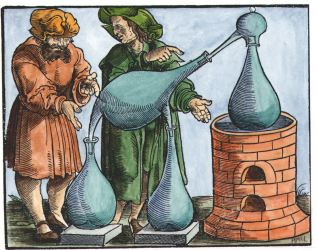The Virgin Mary as Alchemical and
Lullian Reference in Donne

by Roberta Albrecht
This groundbreaking study demonstrates the profound influence of Ramon Lull (ca. 1232-1316?) upon Donne's mind and art, if not his life. Scholars have long known that Donne's library contained a copy of Lull's Duodecim Principia Philosophiae. Never before has anyone studied the many Lullian references in the sermons and poems.
Albrecht traces Donne's ecumenical vision back to Lull, back to Pico della Mirandola, Lull's disciple, and back to the Jewish cabala, source for both. She shows how Donne's Essays in Divinity bear the marks of these models. Donne appropriated Lull's system of "dignities," including the Mother God. This he revised as the "mother of this All" (Essays). He refashioned Lull's abstract version of Mary, and, like Lull, used this "Mary" to try to convert Muslims and Jews, inviting them to join radical Calvinists, Arminians, and Roman Catholics as members of the church universal.
Frances Yates has argued that Lull influenced Italian architecture and Paracelsean theories of medicine and shaped various disciplines in that period now called early modern England. Albrecht demonstrates that pseudo-Lullian theories kept magic alive, even during a time when it was proscribed, and served as the basis for such alchemical theorists as Ripley and Dee. The fact that Lull dabbled in alchemy did not prevent the common perception that he was an adept. Always attracted to things dark and obscure, Donne was fascinated, deriving from pseudo-Lullian concepts his version of "theological alchemy."
Lullian and pseudo-Lullian theories allowed Donne to describe, with impunity, Mary's role in the spiritual Opus. He used them to explore the "mother" side of God, the Creator's Womb, as the alembic in which the alchemical Child is conceived and born. Donne's theological alchemy uses established codes-the World Egg, the Ouroboros, the Androgyne/Dragon, the Phoenix, etc.-all of which are secular analogues for religious "works" such as the sacraments. These argue cooperation between God and mankind in the spiritual Opus. This evidence also supports Nicholas Tyacke's observation that Donne's was essentially "Arminian preaching." Albrecht shows how Donne adapted this worksoriented theology into his concept of the Tetragrammaton-that name that cannot be spoken-to include the female principle in the godhead.
Finally, Albrecht shows how Donne incorporated the corporeal images of medieval iconography into Lull's mnemotechnics in order to construct his own texts as another version of ars combinatoria, God's attributes being perceived as a series of ever-changing combinations. She argues that this Donnean phenomenon anticipates modem film practice, particularly montage.This thesis is illustrated by her reading of the sonnet beginning, "Show me deare Christ, thy spouse, so bright and cleare." This difficult poem can now finally be understood, but only when readers take into consideration how Lullian abstractions combine with corporeal images to solve the riddle, its answer revealing Donne's ecumenical frame of mind, far more advanced than supposed.
This study will also appeal to New Historicists and those interested in alchemy, emblems, or theology.
ISBN 1-57591-094-2
Last edited on Tue Apr 15th, 2008 10:21 am by adammclean
|

